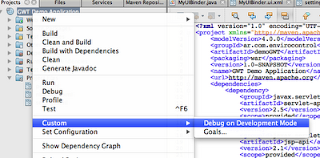On the past I've created a web application based on GWT and in Netbeans IDE. I have to say it was a total nightmare! The version of GWT I worked with is 1.7, now things have changed, version 2.x is here for a long time and there are many tools to work with it.
A piece of advice.
For those who want to start a new GWT project, I still encourage them to use Eclipse IDE with the Google Plugin, the sad truth is eclipse is really MUCH better to work with GWT than Netbeans and has many tools such as visual designers and wizards to do things easy and all of that. Nevertheless, if you use maven you can work with both IDE's and take the best from both worlds!
Let's get started.
First of all you will want to have some help with code editing, refactoring, creating new files out of a template and so on, to do this you want to install the GWT4NB plugin, this plugin can be easily installed on the Netbeans plugin manager or downloaded from the Netbeans page.
This plugins enables the IDE with very helpful stuff, it also works fairly well with maven and ant projects. To use ant you should download the GWT SDK and instruct the plugin on where to find it.
Maven Dependencies
Now we want to have the actual GWT libraries to start coding our application, so we need to include two important dependencies:
- gwt-user: With this dependency we have the core GWT API, we may choose the version we like but the important thing is the scope of this library, we will add this library as provided because we'll only use it when compiling gwt code to javascript, if we don't set this dependency to provided, it will end up on the final WAR making it heavier.
- gwt-servlet: We need this to process RPC requests and it isn't really used on development so we'll set the scope for this dependency to runtime.
<dependency>
<groupId>com.google.gwt</groupId>
<artifactId>gwt-servlet</artifactId>
<version>${gwt.version}</version>
<scope>runtime</scope>
</dependency>
<dependency>
<groupId>com.google.gwt</groupId>
<artifactId>gwt-user</artifactId>
<version>${gwt.version}</version>
<scope>provided</scope>
</dependency>
Now that we have the GWT dependencies and we have no more problems to compile our JAVA code, we need a way to compile the client code into Javascript. Also we need a way to start GWT development mode to be able to test our code, to do this we'll use the Maven GWT plugin.
We can hook (or not) the Maven GWT plugin into our lifecycle, but the very annoying thing of working with GWT on Netbeans (at least for previous releases) is the fact that you end up compiling the GWT client side as many times as you compile the application, and believe me you don't want to waste two extra minutes of your life for each build, so I removed the build hook.
You can fire at will the gwt client side code compilation using the goal gwt:compile of the maven GWT plugin.
<plugin>
<groupId>org.codehaus.mojo</groupId>
<artifactId>gwt-maven-plugin</artifactId>
<version>2.2.0</version>
<executions>
<execution>
<goals>
<!-- remove this to not compile gwt client every time -->
<goal>compile</goal>
<goal>test</goal>
</goals>
</execution>
</executions>
<configuration>
<hostedWebapp>${project.build.directory}/${project.build.finalName}</hostedWebapp>
</configuration>
</plugin>
Running and Debugging in Development Mode
Something brilliant about development mode is the possibility to change code and see the changes as soon as you reload the browser, so we obviously want the ability to do that. The maven GWT plugin provides us with two goals to start the development mode: gwt:run and gwt:debug.
If we choose to use the gwt:debug goal, then the plugin tells us the parameters to attach out JPDA debugger to the hosted mode, and then set breakpoints at will.
Pitfalls and Gotchas
There are some pitfalls and gotchas when working with GWT. The most important one is: If you plan to use a J2EE full profile container (and with it use EJBs and persistence), my advice is: Do not use GWT, or use it in a way you lookup EJBs using JNDI. This is because GWT development mode deploys the application on a Jetty server who knows nothing about EJBs and such. A better solution would be to use the spring framework, not only because it's better but the spring framework doesn't have any problem on running on jetty.
That's all for now, hope you find it helpful.




